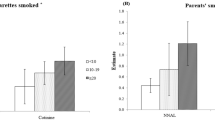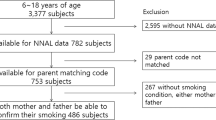Abstract
This study was carried out to investigate how serum cotinine and hydroxycotinine concentrations compare and vary by age, gender, race/ethnicity, smoking, and exposure to environmental tobacco smoke (ETS) at home and other indoor environments. Data from NHANES for 2013–2018 for US children aged 3–11 years (N = 3834), nonsmoker (N = 1963) and smoker (N = 247) adolescents aged 12–19 years, and nonsmoker (N = 10,334) and smoker (N = 3264) adults aged ≥ 20 years were analyzed by fitting regression models with log10 transformed values of serum cotinine and hydroxycotinine as dependent variables. Models stratified by age and smoking status were fitted. Those reporting using tobacco products during the last 5 days were classified as smokers. For cotinine, males had higher cotinine concentrations than females for children, adolescent smokers, and nonsmoker adults. Non-Hispanic Blacks were found to have lower concentrations of both cotinine and hydroxycotinine than non-Hispanic Whites for adult smokers (p < 0.01) only. The ratio of concentrations of those exposed to ETS at home to those not exposed to ETS at home for hydroxycotinine was 6.3 for nonsmoker adults and as low as 1.39 for adult smokers.
Similar content being viewed by others
Data availability
All data used for the analysis for this study are in public domain and available free of charge at www.cdc.gov/nchs/nhanes/index.htm
References
Arger CA et al (2018) Pregnancy-induced increases in the nicotine metabolite ratio: examining changes during antepartum and postpartum. Nicotine Tobacco Res. https://doi.org/10.1093/ntr/nty172
Ashare RL, Thompson M, Leone F, Metzger D, Gross R, Mounzer K, Tyndale RF, Lerman C, Mahoney MC, Cinciripini P, George TP, Collman RG, Schnoll R (2019) Differences in the rate of nicotine metabolism among smokers with and without HIV. AIDS. 33(6):1083–1088. https://doi.org/10.1097/QAD.0000000000002127
Benowitz NL et al (2009, 2009) Nicotine chemistry, metabolism, kinetics, and biomarkers. Handbk Exp Pharmacol (192):29–60. https://doi.org/10.1007/978-3-540-69248-5_2
Caraballo RS, Giovino GA, Pechacek TF, Mowery PD, Richter PA, Strauss WJ, Sharp DJ, Eriksen MP, Pirkle JL, Maurer KR (1998) Racial and ethnic differences in serum cotinine levels of cigarette smokers: Third National Health and Nutrition Examination Survey, 1988-1991. JAMA. 280(2):135–139
Chang CM, Corey CG, Rostron BL, Apelberg BJ (2015) Systematic review of cigar smoking and all cause and smoking related mortality. BMC Public Health 15:390. https://doi.org/10.1186/s12889-015-1617-5
Chen J, Kettermann A, Rostron BL, Day HR (2014) Biomarkers of exposure among U.S. cigar smokers: an analysis of 1999-2012 National Health and Nutrition Examination Survey (NHANES) data. Cancer Epidemiol Biomark Prev 23(12):2906–2915. https://doi.org/10.1158/1055-9965.EPI-14-0849
Chen A, Krebs NM, Zhu J, Muscat JE (2018) Nicotine metabolite ratio predicts smoking topography: the Pennsylvania Adult Smoking Study. Drug Alcohol Dependance 190:89–93. https://doi.org/10.1016/j.drugalcdep.2018.06.003
Chenoweth MJ, Novalen M, Hawk LW, Schnoll RA, George TP, Cinciripini PM, Lerman C, Tyndale RF (2014) Known and novel sources of variability in the nicotine metabolite ratio in a large sample of treatment-seeking smokers. Cancer Epidemiol Biomarkers Prev 23(9):1773–1782. https://doi.org/10.1158/1055-9965.EPI-14-0427
Goniewicz ML, Havel CM, Peng MW, Jacob P, Dempsey D, Yu L, Zielinska-Danch W, Koszowski B, Czogala J, Sobczak A, Benowitz NL (2009) Elimination kinetics of the tobacco-specific biomarker and lung carcinogen 4-(methylnitrosamino)-1-(3-pyridyl)-1-butanol. Cancer Epidemiol Biomarkers Prev 18(12):3421–3425
Jain RB (2014) Trends in serum cotinine concentrations among daily cigarette smokers: data from NHANES 1999-2010. Sc Total Environ. 472:72–77
Jain RB (2015) Serum cotinine and urinary 4-(methylnitrosamino)-1-(3-pyridyl)-1-butanonol levels among non-Hispanic Asian American smokers and nonsmokers as compared to other race/ethnicities: data from NHANES 2011–2012. Chemosphere 120:584–591
Jain RB (2016) Trends in exposure to second hand smoke at home among children and nonsmoker adolescents. Sc Total Environ 542:144–152. https://doi.org/10.1016/j.scitotenv.2015.10.076
Jain RB (2019) Concentrations of urine cotinine and hydroxycotinine among US children, adolescents, and adults: data from NHANES 2013-2014. Biomarkers. 24(8):757–763. https://doi.org/10.1080/1354750X.2019.1684563
Jain RB (2020a) Estimates of cutoffs with specificities and sensitivities for urine cotinine and hydroxycotinine for US adults aged >= 20 years to classify smokers and nonsmokers. Environ Sci Pollut Res 27:10882–10887. https://doi.org/10.1007/s11356-020-07710-x
Jain RB (2020b) Nicotine metabolite ratios in serum and urine among US adults: variations across smoking status, gender and race/ethnicity. Biomarkers. 25:27–33. https://doi.org/10.1080/1354750X.2019.1688866
Jarvis MJ, Russell MA, Benowitz NL, Feyerabend C (1988) Elimination of cotinine from body fluids: implications for noninvasive measurement of tobacco smoke exposure. Am J Public Health 78(6):696–698
Jones MR, Apelberg BJ, Tellez-Plaza M, Samet JM, Navas-Acien A (2013) Menthol cigarettes, race/ethnicity, and biomarkers of tobacco use in U.S. adults: the 1999-2010 National Health and Nutrition Examination Survey (NHANES). Cancer Epidemiol Biomark Prev 22(2):224–232. https://doi.org/10.1158/1055-9965.EPI-12-0912
Keith RJ, Riggs DW, Conklin DJ, Lorkiewicz P, Srivastava S, Bhatnagar A, DeFilippis AP (2019) Nicotine metabolism in adults with type 2 diabetes. Nicotine and Tobaco Research 21(6):846–849. https://doi.org/10.1093/ntr/ntx214
Kosmider L, Delijewski M, Koszowski B, Sobczak A, Benowitz NL, Goniewicz ML (2018) Slower nicotine metabolism among postmenopausal Polish smokers. Pharmacol Rep 70(3):434–438. https://doi.org/10.1016/j.pharep.2017.11.009
Oncken C, et al (2019) Opioid use and rate of nicotine metabolism among pregnant smokers. Nicotine Tobacco Res. pii: ntz073. https://doi.org/10.1093/ntr/ntz073
Perez-Stable EJ et al (1998) Nicotine metabolism and intake among black and white smokers. JAMA. 280(2):152–156
Rostron BL, Chang CM, van Bemmel DM, Xia Y, Blount BC (2015) Nicotine and toxicant exposure among U.S. smokeless tobacco users: results from 1999 to 2012 National Health and Nutrition Examination Survey Data. Cancer Epidemiol Biomark Prev 24(12):1829–1837. https://doi.org/10.1158/1055-9965.EPI-15-0376
Rubinstein ML, Benowitz NL, Auerback GM, Moscicki AB (2008) Rate of nicotine metabolism and withdrawal symptoms in adolescent light smokers. Pediatrics. 122(3):e643–e647. https://doi.org/10.1542/peds.2007-3679
Shahab L, Mortimer E, Bauld L, McGowan JA, McNeill A, Tyndale RF (2017) Characterising the nicotine metabolite ratio and its association with treatment choice: a cross sectional analysis of Stop Smoking Services in England. Sci Rep 7:17613. https://doi.org/10.1038/s41598-017-17994-8
Shenassa ED, Rossen LM, Cohen J, Morello-Frosch R, Payne-Sturges DC (2017) Income inequality and US Children’s secondhand smoke exposure: distinct associations by race-ethnicity. Nicotine Tob Res 19(11):1292–1299. https://doi.org/10.1093/ntr/ntw293
Signorello LB, Cai Q, Tarone RE, McLaughlin JK, Blot WJ (2009) Racial differences in serum cotinine levels of smokers. Dis Markers 27:187–192. https://doi.org/10.3233/DMA-2009-0661
Singh PN et al (2013) Cotinine levels among betel quid users and cigarette smokers in Cambodia. Asia Pac J Public Health 25(5 Suppl):84S–91S. https://doi.org/10.1177/1010539513493459
Tsai J, Homa DM, Gentzke AS, Mahoney M, Sharapova SR, Sosnoff CS, Caron KT, Wang L, Melstrom PC, Trivers KF (2018) Exposure to second hand smoke among nonsmokers – United States, 1988-2014. Mortality and Morbidity Weekly Reports 67(48):1342–1346
U.S. Department of Health and Human Services (2004) The health consequences of smoking: a report of the surgeon general. U.S. Department of Health and Human Services, Centers for Disease Control and Prevention, National Center for Chronic Disease Prevention and Health Promotion, Office on Smoking and Health, Atlanta (GA)
Wald NJ, Idle M, Boreham J, Bailey A (1981) Serum cotinine levels in pipe smokers: evidence against nicotine as cause of coronary heart disease. Lancet. 2(8250):775–777
Author information
Authors and Affiliations
Contributions
The responsibility of executing every aspect of this study was borne by Ram B. Jain. This included conceptualizing and designing the study; generating study database; deciding the methods of statistical analysis; conducting the data analysis; generating, tabulating, and interpreting the study results; and ultimately, writing, reviewing, revising, and finalizing the study manuscript.
Ethics declarations
Conflict of interest
The author declares that he has no conflicts of interest.
Ethical approval
Since this study did not recruit any human and/or animal subjects, this section does not apply.
Consent to participate
Since this study did not recruit any human subjects, this section does not apply.
Consent to publish
Since this study is not attempting to re-publish/publish any third party or author’s previously published material, this section does not apply.
Additional information
Responsible Editor: Lotfi Aleya
Publisher’s note
Springer Nature remains neutral with regard to jurisdictional claims in published maps and institutional affiliations.
Supplementary information
ESM 1
(DOCX 15 kb)
Rights and permissions
About this article
Cite this article
Jain, R.B. Comparative analysis of the concentrations of serum cotinine and hydroxycotinine for US children, adolescents, and adults: impact of exposure to environmental tobacco smoke at home and other indoor environments. Environ Sci Pollut Res 28, 17627–17635 (2021). https://doi.org/10.1007/s11356-020-11838-1
Received:
Accepted:
Published:
Issue Date:
DOI: https://doi.org/10.1007/s11356-020-11838-1




